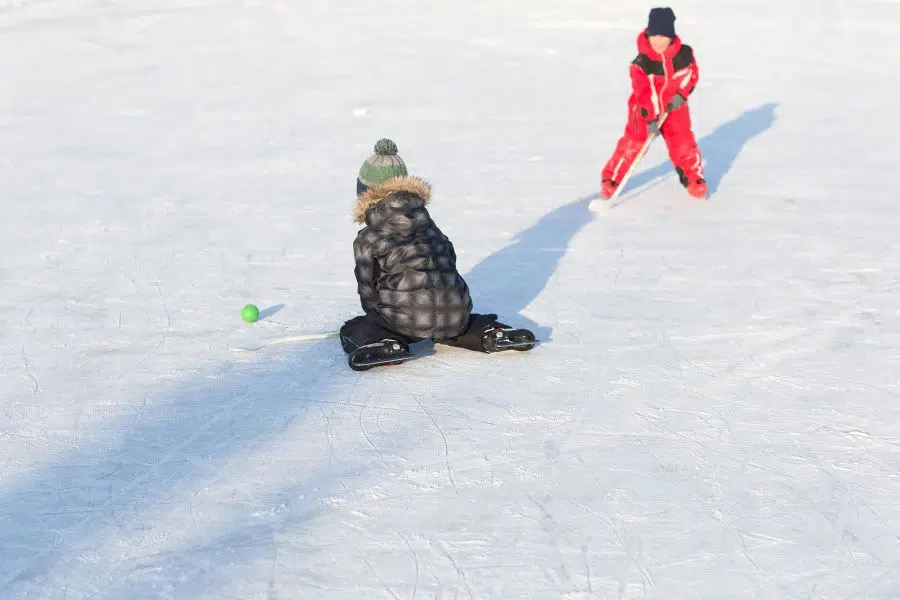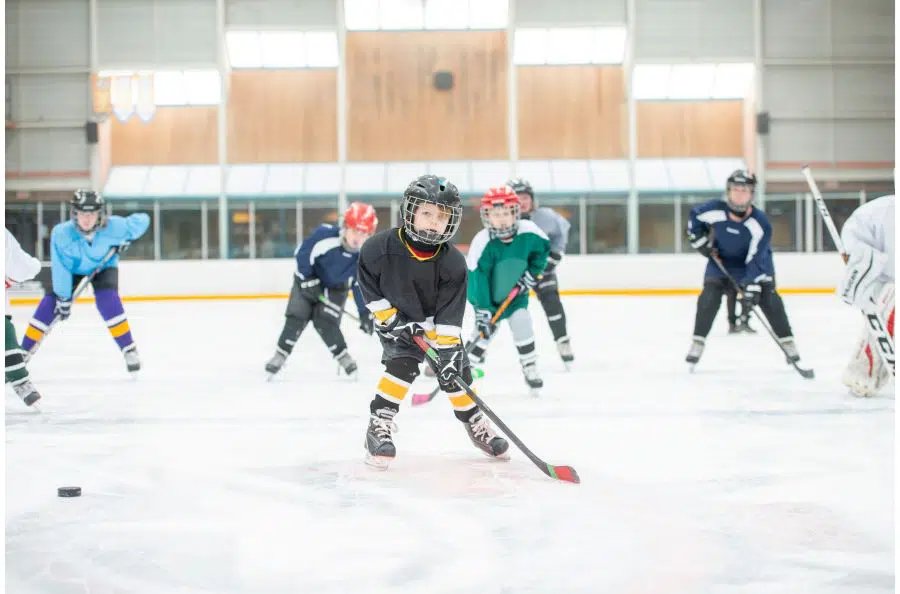The biggest thing about coaching 5-year-olds is getting them to have fun. Period.
Kids that are mad keen on hockey are going to develop a lifelong love for the sport! Your job as a coach is crucial in firing up this passion, and getting them started on the road to a lifetime’s obsession with hockey.
In this post, I’ll look at the ultimate hockey drills for 5 year-olds.
All of these combine:
- Fun!
- Lots of activity and repetition
- Game-based learning
- And they work!
Let’s dive into the drills:

12 Hockey Drills For 5 Year Olds
There are dozens of hockey drills for kids to improve their skills and prepare them for bigger games. The goal is to support the development of a sound skill base so young players will experience success playing the game (Source).
1. Warm-Up
Always begin with a warm-up. Teach them a few necessary stretches and ask them to do some general running pre-practice.
The first 10 – 15 minutes of practice is crucial for setting the tempo and getting players warmed up and engaged (Source).
2. Blocking – Indoor Practice Drill
This drill is perfect for building hand-eye coordination skills. Create a court indoor on your floor with some tape and give the kids balls or pucks which they have to stop from crossing their respective lines to defend their goals.
3. Skate Circles
The most basic drill for beginning ice hockey training for your little one is skate circles. You can use this drill during warm-ups as well.
Place two skaters at adjacent corners of an ice field and blow the whistle. Tell the kids to glide around all circles that you have made on the field while executing the figure ‘8’.
4. Horseshoe Give and Go
Your 5-year-old must know the basics of ice skating to perform these drills.
This is not a solo drill.
This drill’s intention is to improve the kid’s skating speed, stick-handling, and passing skills.
Place cones in the middle of the face-off circles you previously made. Tell the player to skate horseshoe around half-ice cones.
Tell the other kids to join the first player and pass the puck with the intention of hitting the skater in stride.
5. Scrimmages
Scrimmages help in developing passing skills and shooting fundamentals. These are necessarily incorporated by coaches to develop chemistry among the team members while adding the element of fun.
6. Shootouts
Hand your kid a stick and tell them to take the puck towards the net or goal with it. Shootouts are fun and they help in building skating speed.
These also help develop goalie’s confidence by facing skaters one-on-one. You can make this a solo drill, or with multiple players, so one of them can act as the goalie.

7. Sharks and Minnows
This drill helps the young players improve in stickhandling and skating. Make two teams namely sharks and minnows.
Start this drill by lining minnows up alongside the boards with pucks, while one shark opens in the middle of the ice.
Tell the kids to try to skate dot to dot, while the minnows weave around the ice trying to avoid a shark’s attempt to knock the puck off their sticks.
If the team of minnows makes it to the area between the dots and the boards, they are considered safe.
However, if they lose control of the puck somehow, they will become a part of the shark’s team. When all the minnows have lost their pucks to the sharks, the game ends.
8. Relay Races
Races have always been a great way to increase a player’s balance and agility. Create little obstacles for your little one – like sticks they must jump over, or cones for working on turning strategy.
Dividing a team into groups and then making them race against each other boosts encouragement and makes for a great, fun game.
9. Find Your Stick
This drill is a great way to begin the practice. Take the sticks of all the team players, mix them up and place them on the far side of the field.
When you blow the whistle, kids are required to skate over to the other side of the field to find their sticks. They have to skate back to where they started.
The goal here is to make them avoid being the last person back.
10. Finders Keepers
This is a great game and a very productive activity for players. It gets as many children involved as you like.
Put 1 puck in a designated area for every 2 players whom you have. The players have to individually fight for the puck until the time you allotted runs out.
Keep the time limit short as it creates thrill and keeps the energy high. Blow the whistle at the end and the last player standing with the puck is the winner.
11. Stop and Start
This is a one-on-one race for a puck. You can make this race as small as you want. To create a twist, you can add in extra obstacles around which the players have to skate to get the puck in their possession.
12. Side-by-Side Skills Race
This drill requires cones in addition to skating gear, hockey sticks, and pucks.
Set the cones linearly throughout the field and make the players race through them while practicing a specific skill, any skill. This teaches them puck protection and awareness.
7 Tips For Delivering These Drills
Here are 7 tips to make the practice of your little one easy for them (and you!).
- Use games like Cops and Robbers, Musical Pucks, Tag, British Bulldog, etc. to start practicing. These are considered brain and body energizers. This lets the players blow off steam before you try to teach them anything technically specific. Starting with a game gets them excited to get dressed and get to work.
- Alternate a mix of isolated skill drills and games throughout practice. Dedicate 5-10 minutes for each drill.
- Don’t over-teach the techniques. Teach 1-2 points maximum daily.
- In practice routine, add knee slides, dives, rolls, etc. to build and increase agility, balance, and confidence.
- Kids don’t need to run a reverse breakout or a regroup, so keep your expectations to a low.
- A great tip to begin the practice for ice hockey is to use a tennis ball or a soccer ball. These are easier to hit than a puck.
- Using a type of ball for ice hockey practice also keeps the kids from harm’s way. This way, kids can practice with safety. They can play goalie without being hurt by a shot with a real puck.
Psychological and Physical Benefits
These drills have several health benefits for little kids, including psychological and physical ones.
These ensure that the child learns the basics of ice hockey while having fun, so in the future, the actual games will not be a burden to them. In practice, kids experience success which adds positivity to their psychology.
These drills teach the children to work within groups, hence promoting teamwork which is essential in ice hockey and other similar sports.
With the help of these practices, the child develops a positive attitude towards physical activities and play.
The physical advantages include the development of agility, stamina, and strength. Other benefits are practicing balance, body coordination, and speed.
Let’s Get Practicing!
Early practice will get your kid ready for further complicated sports vision training programs that will improve their visual performances.
Without fitness and early practice, training young athletes to meet the standards of older age groups and higher levels of hockey may be inefficient and effective.
Sources
Timbits Under-7 Hockey Practice Plans https://www.hockeycanada.ca/en-ca/hockey-programs/drill-hub/under-7.
11 Warm-up Activities & Drills For Youth Hockey Practice https://www.icehockeysystems.com/blog/coaching-tips/11-warm-activities-drills-youth-hockey-practice.
Beginner Level Training Intensive | iTrain Hockey https://www.youtube.com/watch?v=vFXLiGizDuo
